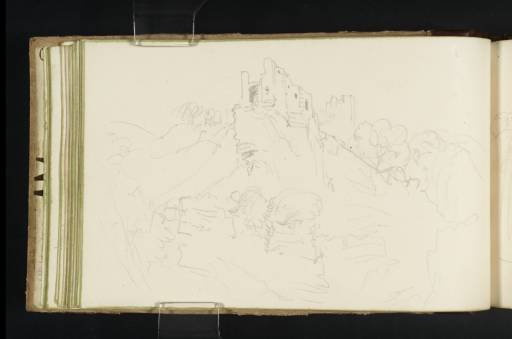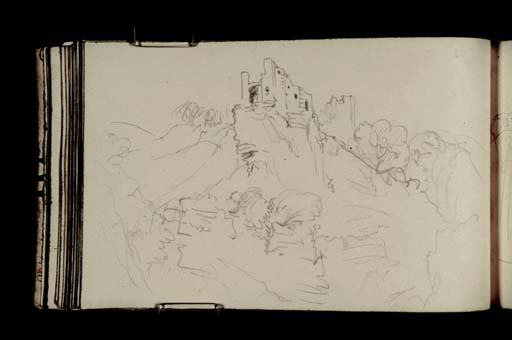J.M.W. Turner
>
1830-35 Annual tourist
>
Scotland 1831
>
Abbotsford Sketchbook
>
Artwork
Joseph Mallord William Turner Innerwick Castle, East Lothian 1831
Image 1 of 2
Joseph Mallord William Turner,
Innerwick Castle, East Lothian
1831
Joseph Mallord William Turner 1775–1851
Folio 28 Verso:
Innerwick Castle, East Lothian 1831
D25977
Turner Bequest CCLXVII 28a
Turner Bequest CCLXVII 28a
Pencil on off-white wove writing paper, 113 x 185 mm
Accepted by the nation as part of the Turner Bequest 1856
References
1909
A.J. Finberg, A Complete Inventory of the Drawings of the Turner Bequest, London 1909, vol.II, p.858, CCLXVII 28a, as ‘Ruined castle on hill.’.
1972
Gerald E. Finley, ‘J.M.W. Turner and Sir Walter Scott: Iconography of a Tour’, Journal of the Warburg and Courtauld Institutes, vol.35, 1972, p.367 note 51.
It is not clear why Turner had a specific interest in Innerwick Castle as it was not a subject that was ever under consideration to illustrate Sir Walter Scott’s Poetical Works, the publishing project for which Turner was in Scotland in 1831. However, it was important enough for the artist to spend two extra days (12–13 August) getting from Berwick-upon-Tweed to Edinburgh in order to see it along with Yester Castle, Dunbar, Hailes Castle and Haddington Church on the way.1 Perhaps he just wanted to fill some of the gaps in his knowledge of East Lothian, which he had covered fairly extensively in visits of 1801, 1818 and 1822.
Turner would have been aware of Revd John Thomson of Duddingston’s illustration of Innerwick Castle for the seventh number of the Provincial Antiquities and Picturesque Scenery of Scotland, a publication with text by Scott that Turner had travelled to Scotland in 1818 to contribute towards, including two illustrations in this issue.2 This connection, and perhaps conversations with the artist in 1818, may have inspired Turner’s visit to the ruin.
Innerwick Castle sits on the edge of a deep glen (which Thornton Burn flows through) near the village of Innerwick, which lies halfway between Cockburnspath and Dunbar. Sketches of the ruins are hard to identify because little of the castle remained in Turner’s day, and the little that stands today is largely obscured by trees. Gerald Finley, however, managed to identify the present sketch,3 and a number of similar looking sketches can thus also be identified as the same structure (folios 10 verso, 29, 29 verso, 36, 53 and 58 verso; D25945, D25978, D25979, D25988, D26017 and D26029; CCLXVII 10a, 29, 29a, 36, 53, 60a).
The view was taken from the east-north-east with the ruins high on the west bank of the glen above the burn.
Turner’s other sketches of the castle are from similar angles, including the sketch opposite this one on folio 29, which is from the south-east of the castle and so shows its other side.
Thomas Ardill
September 2009
See Robert Cadell, ‘Abbotsford Diary’, Thursday 11 August 1831, National Library of Scotland, MS Acc.5188, Box 1, folio 111 verso; transcribed in Gerald E. Finley, ‘J.M.W. Turner and Sir Walter Scott: Iconography of a Tour’, Journal of the Warburg and Courtauld Institutes, vol.31, 1972, p.385.
How to cite
Thomas Ardill, ‘Innerwick Castle, East Lothian 1831 by Joseph Mallord William Turner’, catalogue entry, September 2009, in David Blayney Brown (ed.), J.M.W. Turner: Sketchbooks, Drawings and Watercolours, Tate Research Publication, December 2012, https://www


